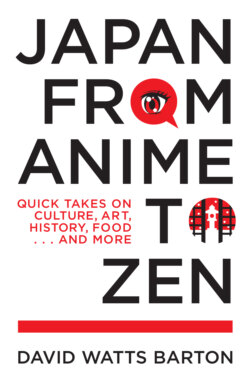Читать книгу Japan from Anime to Zen - David Watts Barton - Страница 16
На сайте Литреса книга снята с продажи.
5. Rice and Its Many Products
ОглавлениеWhen one wants to say “meal” in Japanese, one says the word gohan or perhaps meshi. Both words literally mean “cooked rice.” That etymology says much about the central role that rice plays in the Japanese diet. Valued as currency in the past, rice is still used in a remarkable variety of ways, from housing elements to cosmetics to booze to, yes, food. Without rice, the Japanese diet wouldn’t be very Japanese.
Asian wet rice, or “paddy” rice—known by the botanical name Oryza sativa—is an annual grass that is grown from spring to fall all over Japan, the seasons varying with the latitude of the area. The variety grown in Japan, known as Oryza sativa japonica, thrives in the archipelago because it likes Japan’s more temperate climate, rather than the tropical climate favored by its botanical cousin Oryza s. indica. In fact, some strains of Japanese rice have been developed to grow in northern climates that few would think of as capable of supporting rice cultivation.
Of the nearly 2.5 million farms in Japan, roughly 85% are dedicated at least in part to growing rice, even though the average Japanese rice farm is less than two acres. Because of this, these farms make but a tiny profit and most rice farmers cultivate the crop as a part-time vocation. Consequently, most rice farmers are more than sixty-five years old.
Despite the ubiquity of this crop, the volume of paddy rice grown in Japan as of 2017 is barely more than 11 million metric tons, just a third of the 33 million metric tons grown in Thailand and a quarter of the 44 million metric tons grown in Vietnam. Production in Indonesia, Bangladesh, India, and China far outstrips Japan’s. But despite government regulation, which subsidizes farmers and bans competition from imported rice, rice farming in Japan is in steady decline. Rice in Japan is also very expensive, five to six times more expensive than in other rice-centric countries, a fact that Japanese accept because of what they consider its superior quality.
The Japanese remain passionate about rice, and visitors may be surprised to find they are eating rice in forms that may not be obvious. In addition to rice in dishes such as sushi, donburi, chahan (fried rice), omuraisu (omelet rice), onigiri (rice balls), and breakfast dishes such as kayu (rice porridge) and tamago kake gohan (egg rice), a visitor will also likely be consuming rice in noodles, sake, bread and pastries made with rice flour, and desserts such as wagashi and ice-cream-filled mochi.
Many of those foods depend on the particular qualities of the japonica variety, which is a short-grain rice that is stickier than rice grown in other regions. This makes the rice clump more easily, which, as anyone who has had nigiri-zushi or onigiri knows, is a crucial element of these staples.
Non-edible rice products are also a part of daily life in Japan. Primary among them is rice straw, the non-edible part of the plant, which constitutes about half the biomass created by rice farming. It is a troublesome byproduct because of the air pollution created when it is burned, a common practice all over the rice-growing world. The Japanese, ever keen to use every part of everything they grow, have found myriad uses for this rice byproduct, from roofing material to feed for livestock.
Most ingenious is the use of rice straw to create one of the Japanese home’s most distinctive features: the tatami floor. Created from up to 35 kilograms of highly compressed rice straw, tatami mats offer solid-yet-yielding flooring that works beautifully with the traditional Japanese habit of sitting and even sleeping on the floor.
Another rice byproduct is the husks that are removed from the rice grains during processing. White rice may be nutritionally inferior to whole-grain rice because it lacks fiber, but Japanese prefer its taste, and it is certainly more useful in the creation of staples such as mochi, rice flour, rice noodles, and sake. Rice husks are used in the production of important items such as bedding, seedbeds for other crops, livestock feeds, ceramics, filters, and even oil, the source of rice bran wax, which is used in some cosmetics.
Today rice cultivation and even consumption is in overall decline in Japan. On average, Japanese consumption per capita has declined by a remarkable 50% since 1965, as the Japanese diet and lifestyle have grown ever-more international. But rice retains a unifying and symbolic significance. In a country in which more than half of foods consumed are imported, rice remains symbolic of the desire for food security and even of national identity. Eating Japanese rice—the only kind of rice most Japanese know—is considered one’s patriotic duty, a tasty duty indeed.
